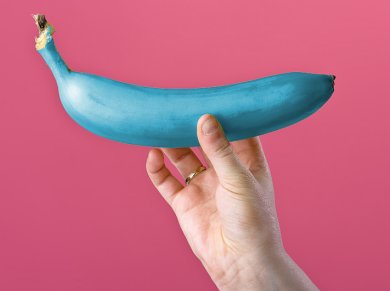Blue Glow
Yellow leaves on banana plants give off a blue glow when viewed under UV light. This luminescence comes from decomposition products of chlorophyll, the substance that makes leaves green. The decomposition products are appended with special sugar molecules in a unique fashion (hypermodified), and accumulate in ageing leaves, as Bernhard Kräutler and his team from the University of Innsbruck (Austria) report in the journal Angewandte Chemie. The researchers speculate that these long-lived chlorophyll decomposition products have physiological significance.
In other higher plants, such as apples and pears, mainly colorless, nonfluorescent chlorophyll decomposition products are found. Fluorescing decomposition products have been detected in ageing leaves before, but these have been short-lived intermediate products of chlorophyll degradation. Some time ago, Kräutler and his co-workers discovered that bananas give off a blue glow under UV light. As the bananas ripen, chlorophyll decomposition products that are colorless, but fluoresce blue, accumulate in the banana peel.
Complex Pigments
The compounds in the banana peels and leaves differ from each other, but they are both long-lived (persistent). In addition, the compounds have a structural similarity: a unique, complex ester function on a specific side chain. This group has a chemical stabilizing effect and explains the unusually long life of the fluorescing intermediates in the banana and its leaves. The leaf decomposition product, called Ma-FCC-61, is a pyrrole pigment with a previously unknown sugar unit attachment. The researchers do not rule out that this novel chlorophyll decomposition product could be a building block for previously undetected and even more complex pigments.
“When leaves of plants de-green and when fruits ripen, they develop fascinating colors,” says Kräutler. “Bright colors of fruit are believed to have evolved as valuable signals to attract frugivores, which are needed for seed dispersal. Indeed, the blue luminescence of ripe bananas may fulfill such a role,” according to Kräutler. The additional “advertisement” of fruit with colorful and possibly luminescent leaves could be a further optical signal from fruiting plants. “In any case, we need to reconsider the previous assumption that chlorophylls in ageing leaves are always disposed of by a general route leading to nonfluorescent decomposition products,” says Kräutler.
- Hypermodified Fluorescent Chlorophyll Catabolites: Source of Blue Luminescence in Senescent Leaves
S. Banala, S. Moser, T. Müller, C. Kreutz, A. Holzinger, C. Lütz, B. Kräutler,
Angew. Chem. Int. Ed. 2010, 49.
DOI: 10.1002/anie.201000294 - S. Banala, S. Moser, T. Müller, C. Kreutz, A. Holzinger, C. Lütz, B. Kräutler,
Angew. Chem. 2010, 122.
DOI: 10.1002/ange.201000294



